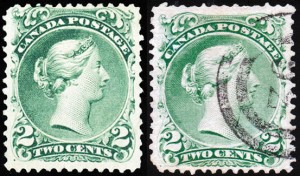
It pays to look closely at stamps. The example of the two-cent large queen shown at left is a normal example, while the stamp at right has an elusive stitch watermark, and is worth substantially more.
While most watermarks are placed on the paper intentionally during the manufacturing process, one kind, the stitch watermark, appears totally by accident.
A hallmark of early paper making processes, it rarely appears on modern stamps, but is eagerly sought after by collectors specializing in stamps of the Victorian era.
They can also be illusive, but their presence often raises the value of a stamp dramatically.
Modern paper making, developed in the early 1800s, was one of the first continuous manufacturing processes invented. It owes its existence to a unique property of the plant fibres used to make paper, in the presence of water they bond together, and that bond remains after they dry.
Originally paper was produced in sheets using wooden frames, a process that was both time consuming and slow as manufacturers had to wait for the paper to dry before putting the forms back to work. The continuous process was created in the 1790s by French inventor Nicolas Robert, working with his employer, paper maker Saint-Leger Didot. While Robert was granted a patent, Didot also claimed ownership.
The two fought a protracted legal battle and in the end Didot won.
Didot reasoned that France, just coming out of the violent and chaotic French Revolution, was not a good economic climate and arranged for his English brother-in-law, John Gamble, to look for partners in Britain to develop the system further and make it commercially viable.
Henry and Sealy Fourdrinier took up the challenge. They were sons of a successful London papermaker and stationery producer.
They perfected a machine which starts with a slurry of fibre and after removing some of the water runs it through a series of rollers. Some are heated to aid drying while others compress the paper to the desired thickness and even finish the surface. At the end the paper is sliced to the desired size and placed on rolls.
In the early part of the process, the paper and water mix is not strong enough to stand the stress alone, and is transported through the machine on belts.
The process is the basis of paper making and it remains virtually unchanged today. One area that has improved are the belts. Modern belts are continuous strips of synthetic material, back a century ago they were cloth or wire with seams every few hundred feet.
The seams were joined, by stitching. Paper made where there was a stitch would be slightly thinner because of them, and that thinning appears on the paper in the form of a group of parallel or wavy lines running through the stamp. Spotting them takes an eagle eye, and usually the assistance of watermark detecting fluid and back lighting.
The process is quite different from other watermarks, such as laid lines, makers’ names, or security features, which are intentionally added using what is called a dandy roll. Examples of makers’ names are the Bothwell and Pirie watermarks familiar to collectors of Victorian-era stamps.
Stitch watermarks often don’t survive the production process, and can’t be documented or predicted. Early stamps were invariably printed on sheet-fed presses, meaning paper produced on rolls would be cut into sheets and packaged before shipping to a printer.
That means that stitch watermarks can run horizontally or vertically across a stamp. It also means that since the watermark may have been partially eliminated during the final finishing, a watermark may not cross the entire width or length of a stamp.
What does a stitch watermark mean to a stamp’s value? Quite a bit.
In the large queen series, where stitch watermarks are well-documented, Unitrade consistently places the value of a stitch watermark at a substantially higher amount than other watermarks, and often even above the more exotic varieties. It isn’t unusual to see the catalogue value of a stitch watermark to be three or up to 10 times higher than the common version of the same stamp. Unitrade’s Specialized Catalogue of Canadian Stamps lists a fair number of early stamps with stitch watermarks.
The three-cent red, Unitrade #25 is valued at $20 in used Fine, $200 with a Bothwell watermark, and $600 with a vertical stitch.
The six-cent dark brown, Unitrade #27, is valued at $60 in used Fine, $1,500 with a Bothwell watermark, $1,500 with a vertical stitch and $1,750 with a horizontal stitch.
The 121/2-cent blue Unitrade #28, is valued at $60 in used Fine, $125 on Bothwell paper, and $1,500 with a horizontal stitch watermark.
Stitch watermarks also occurred in the small queen issue such as the two-cent green, Unitrade #36, which is valued at just a few dollars in used Fine, but swoops up to $300 to $400 with a vertical or horizontal stitch watermark.
The watermark also appears with less frequency in the numeral and King Edward VII issues.
As for the Fourdrinier brothers, the cost of developing their process, combined with loose copyright laws meant that they ended up going broke. Later the British Parliament voted them an extension to their patents and a cash allowance but even that proved inadequate.
Eventually, the British paper-making industry created a fund to provide them a comfortable annuity. It was too late for Sealy, who had already died, but Henry was able to live out his life in a comfortable retirement.

